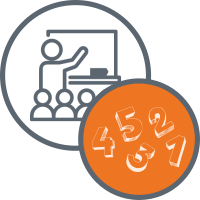You are here
Effective Mathematics Teaching Practice 3: Use and Connect Mathematical Representations
Instructional Support Menu
Use and Connect Mathematical Representations
Most of NCTM’s attention to the practice use and connect mathematical representations focuses on helping students make connections between contextual, visual, verbal, physical, and symbolic representational forms. By seeing and representing mathematics in different forms, students are more able to connect and make sense of mathematical ideas, and offer opportunities for understanding and communicating for all students, particularly those who may struggle due to learning difficulties or because the language used in the classroom is not their first language. The ability to flexibly move between different representations is also important. A quality curriculum should provide students purposeful and regular opportunities to move between representations. Some of these moves could be considered a part of mathematical modeling, such as taking contextual forms and producing a graph, table, or equation, but moving in the other direction—such as starting with a table or graph and conjecturing about possible details of a context—are equally important.
Effective teaching of mathematics engages students in making connections among mathematical representations to deepen understanding of mathematics concepts and procedures and as tools for problem solving.
-NCTM (2014), p. 24
The Practice in Action
One of the ways NCTM (2014, p. 29) summarizes the practice of use and connect mathematical representations is by describing a set of actions expected of teachers and students that indicate engagement in this teaching practice.
Caution! Don't over-estimate your own understanding based on these brief descriptions of teaching practice. Professional educators should dig more deeply into NCTM's resources, join study groups and professional networks, and seek out professional development and coaching to ensure high-quality engagement in the practice.
What are teachers doing?
- Selecting tasks that allow students to decide which representations to use in making sense of the problems.
- Allocating substantial instructional time for students to use, discuss, and make connections among representations.
- Introducing forms of representations that can be useful to students.
- Asking students to make math drawings or use other visual supports to explain and justify their reasoning.
- Focusing students’ attention on the structure or essential features of mathematical ideas that appear, regardless of the representation.
- Designing ways to elicit and assess students’ abilities to use representations meaningfully to solve problems.
What are students doing?
- Using multiple forms of representations to make sense of and understand mathematics.
- Describing and justifying their mathematical understanding and reasoning with drawings, diagrams, and other representations.
- Making choices about which forms of representations to use as tools for solving problems.
- Sketching diagrams to make sense of problem situations.
- Contextualizing mathematical ideas by connecting them to real-world situations.
- Considering the advantages or suitability of using various representations when solving problems.
Resources
- Principles to Action: Ensuring Mathematical Success for All (NCTM, 2014, pp. 24-29)
- Taking Action: Implementing Effective Mathematics Teaching Practices in K-Grade 5 (NCTM, 2017, pp. 119-143)
- Taking Action: Implementing Effective Mathematics Teaching Practices in Grades 6-8 (NCTM, 2017, pp. 99-121)
- Taking Action: Implementing Effective Mathematics Teaching Practices in Grades 9-12 (NCTM, 2017, pp. 99-123)
- Enhancing Classroom Practice with Research behind Principles to Actions (NCTM, 2017, pp. 27-36)




Connect With Us





